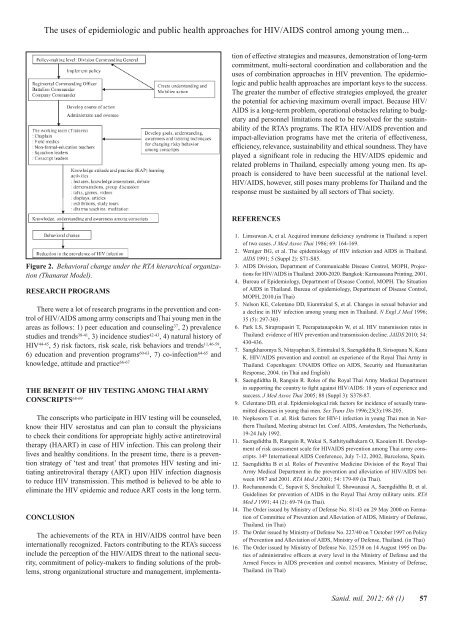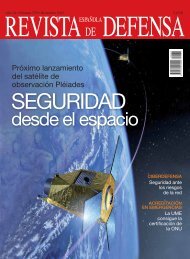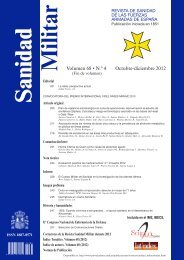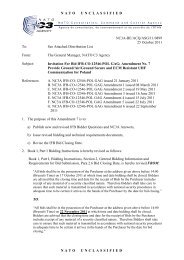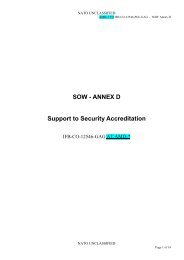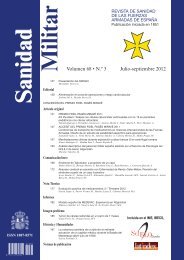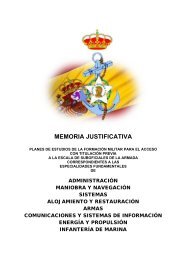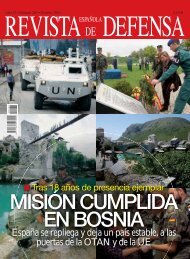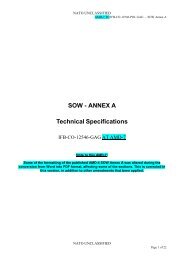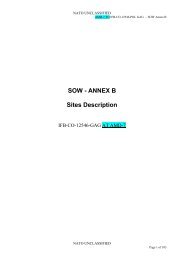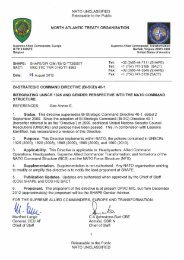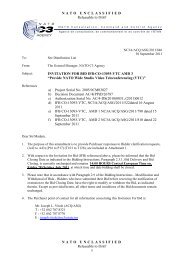Sanidad Militar - Ministerio de Defensa
Sanidad Militar - Ministerio de Defensa
Sanidad Militar - Ministerio de Defensa
You also want an ePaper? Increase the reach of your titles
YUMPU automatically turns print PDFs into web optimized ePapers that Google loves.
The uses of epi<strong>de</strong>miologic and public health approaches for HIV/AIDS control among young men...<br />
The achievements of the RTA in HIV/AIDS control have been<br />
internationally recognized. Factors contributing to the RTA’s success<br />
inclu<strong>de</strong> the perception of the HIV/AIDS threat to the national security,<br />
commitment of policy-makers to finding solutions of the problems,<br />
strong organizational structure and management, implementation<br />
of effective strategies and measures, <strong>de</strong>monstration of long-term<br />
commitment, multi-sectoral coordination and collaboration and the<br />
uses of combination approaches in HIV prevention. The epi<strong>de</strong>miologic<br />
and public health approaches are important keys to the success.<br />
The greater the number of effective strategies employed, the greater<br />
the potential for achieving maximum overall impact. Because HIV/<br />
AIDS is a long-term problem, operational obstacles relating to budgetary<br />
and personnel limitations need to be resolved for the sustainability<br />
of the RTA’s programs. The RTA HIV/AIDS prevention and<br />
impact-alleviation programs have met the criteria of effectiveness,<br />
efficiency, relevance, sustainability and ethical soundness. They have<br />
played a significant role in reducing the HIV/AIDS epi<strong>de</strong>mic and<br />
related problems in Thailand, especially among young men. Its approach<br />
is consi<strong>de</strong>red to have been successful at the national level.<br />
HIV/AIDS, however, still poses many problems for Thailand and the<br />
response must be sustained by all sectors of Thai society.<br />
REFERENCES<br />
Figure 2. Behavioral change un<strong>de</strong>r the RTA hierarchical organization<br />
(Thanarat Mo<strong>de</strong>l).<br />
RESEARCH PROGRAMS<br />
There were a lot of research programs in the prevention and control<br />
of HIV/AIDS among army conscripts and Thai young men in the<br />
areas as follows: 1) peer education and counseling 37 , 2) prevalence<br />
studies and trends 38-41 , 3) inci<strong>de</strong>nce studies 42-43 , 4) natural history of<br />
HIV 44-45 , 5) risk factors, risk scale, risk behaviors and trends 11,46-59 ,<br />
6) education and prevention programs 60-63 , 7) co-infection 64-65 and<br />
knowledge, attitu<strong>de</strong> and practice 66-67<br />
THE BENEFIT OF HIV TESTING AMONG THAI ARMY<br />
CONSCRIPTS 68-69<br />
The conscripts who participate in HIV testing will be counseled,<br />
know their HIV serostatus and can plan to consult the physicians<br />
to check their conditions for appropriate highly active antiretroviral<br />
therapy (HAART) in case of HIV infection. This can prolong their<br />
lives and healthy conditions. In the present time, there is a prevention<br />
strategy of ‘test and treat’ that promotes HIV testing and initiating<br />
antiretroviral therapy (ART) upon HIV infection diagnosis<br />
to reduce HIV transmission. This method is believed to be able to<br />
eliminate the HIV epi<strong>de</strong>mic and reduce ART costs in the long term.<br />
CONCLUSION<br />
1. Limsuwan A, et al. Acquired immune <strong>de</strong>ficiency syndrome in Thailand: a report<br />
of two cases. J Med Assoc Thai 1986; 69: 164-169.<br />
2. Weniger BG, et al. The epi<strong>de</strong>miology of HIV infection and AIDS in Thailand.<br />
AIDS 1991; 5 (Suppl 2): S71-S85.<br />
3. AIDS Division, Department of Communicable Disease Control, MOPH, Projections<br />
for HIV/AIDS in Thailand: 2000-2020. Bangkok: Karnsassana Printing, 2001.<br />
4. Bureau of Epi<strong>de</strong>miology, Department of Disease Control, MOPH. The Situation<br />
of AIDS in Thailand. Bureau of epi<strong>de</strong>miology, Department of Disease Control,<br />
MOPH, 2010.(in Thai)<br />
5. Nelson KE, Celentano DD, Eiumtrakul S, et al. Changes in sexual behavior and<br />
a <strong>de</strong>cline in HIV infection among young men in Thailand. N Engl J Med 1996;<br />
35 (5): 297-303.<br />
6. Park LS, Siraprapasiri T, Peerapatanapokin W, et al. HIV transmission rates in<br />
Thailand: evi<strong>de</strong>nce of HIV prevention and transmission <strong>de</strong>cline. JAIDS 2010; 54:<br />
430-436.<br />
7. Sangkharomya S, Nitayaphan S, Eimtrakul S, Saengdidtha B, Sirisopana N, Kana<br />
K. HIV/AIDS prevention and control: an experience of the Royal Thai Army in<br />
Thailand. Copenhagen: UNAIDS Office on AIDS, Security and Humanitarian<br />
Response, 2004. (in Thai and English)<br />
8. Saengdidtha B, Rangsin R. Roles of the Royal Thai Army Medical Department<br />
in supporting the country to fight against HIV/AIDS: 18 years of experience and<br />
success. J Med Assoc Thai 2005; 88 (Suppl 3): S378-87.<br />
9. Celentano DD, et al. Epi<strong>de</strong>miological risk factors for inci<strong>de</strong>nce of sexually transmitted<br />
diseases in young thai men. Sex Trans Dis 1996;23(3):198-205.<br />
10. Nopkesorn T et. al. Risk factors for HIV-1 infection in young Thai men in Northern<br />
Thailand, Meeting abstract Int. Conf. AIDS, Amsterdam, The Netherlands,<br />
19-24 July 1992.<br />
11. Saengdidtha B, Rangsin R, Wakai S, Sathityudhakarn O, Kaoaiem H. Development<br />
of risk assessment scale for HIVAIDS prevention among Thai army conscripts.<br />
14 th International AIDS Conference, July 7-12, 2002, Barcelona, Spain.<br />
12. Saengdidtha B et al. Roles of Preventive Medicine Division of the Royal Thai<br />
Army Medical Department in the prevention and alleviation of HIV/AIDS between<br />
1987 and 2001. RTA Med J 2001; 54: 179-89 (in Thai).<br />
13. Rochananonda C, Supavit S, Srichaikul T, Showanasai A, Saengdidtha B, et al.<br />
Gui<strong>de</strong>lines for prevention of AIDS in the Royal Thai Army military units. RTA<br />
Med J 1991; 44 (2): 69-74 (in Thai).<br />
14. The Or<strong>de</strong>r issued by Ministry of Defense No. 81/43 on 29 May 2000 on Formation<br />
of Committee of Prevention and Alleviation of AIDS, Ministry of Defense,<br />
Thailand. (in Thai)<br />
15. The Or<strong>de</strong>r issued by Ministry of Defense No. 227/40 on 7 October 1997 on Policy<br />
of Prevention and Alleviation of AIDS, Ministry of Defense, Thailand. (in Thai)<br />
16. The Or<strong>de</strong>r issued by Ministry of Defense No. 125/38 on 14 August 1995 on Duties<br />
of administrative officers at every level in the Ministry of Defense and the<br />
Armed Forces in AIDS prevention and control measures, Ministry of Defense,<br />
Thailand. (in Thai)<br />
Sanid. mil. 2012; 68 (1) 57


